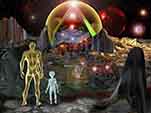A wonderfully written article by CGI member ScienceTruth.
***********************************
By ScienceTruth
The Winnemucca Institute for Advanced Studies presents
Written permission is hereby granted to any and all readers to copy/paste/save any and all of these postings
from July 11 (Friday) and then every Saturday since and continuing !
(these are all very important, please save them all !)
Angular Momentum as the Historian of our Solar System *
* This is from an original article by Wallace Thornhill on his website "holoscience.com"
and titled "Assembling the Solar System". This entire article was previously saved, then a major portion extracted,
and moderately edited, also somewhat added to, and this new title is perhaps equally fitting.
I just checked !! this website has been 'resurrected' from the past, and this article is there, but in a very different form,
https: //www.holoscience.com/wp/assembling-the-solar-system/
Here is what I saved, edited, added to, and retitled.
And I genuinely give full credit to the genius of Wal Thornhill for figuring all of this out !!!
Angular Momentum as the Historian of our Solar System
by Wallace Thornhill
By doing a comparative analysis of the axial tilt and orientation on all of the planets and moons in our solar system, would it be possible to determine a family tree of past relationships ? Axial nutation, precession, and wobble are all clues to serious disturbances from electro-gravitational close encounters, and electrically induced orbital capture events in the past.
Perhaps the most significant problem with the gravity-only Standard Solar System Model is how to explain the near circularity and long term stability of the solar system's major planets' orbits. Mathematics and numerous computer modelings show us that more than two bodies moving solely under the influence of gravity will produce a chaotic system. There is no 'restoring force' when a planet is even slightly perturbed in its orbit under Newtonian Laws.
In a gravity-only solar system model, the stellar capture of other bodies into becoming orbiting planets, or the creation of double star systems, is much more than highly improbable, because; gravitational interaction tends to throw two objects away from each other, and not into a mutual orbiting society. When galaxies collide they pass right thru each other, the stars don't collide or form double star systems. The space between individual stars is much too great for that to occur, and computer simulations of gravitational interactions show that stars will influence and perturb each others' paths, but this will not result in a 'gravitational capture' or collision between any two stars. Two galaxies will pass completely thru each other without any stellar collisions or orbiting gravitational captures occurring, but the two galaxies themselves will become seriously distorted or even torn apart in the big picture of their overall structural shapes, yet all the individual stars will remain undamaged !
Let's assume, and for very good reasons, that brown dwarf stars and their satellites are the most hospitable places in the Universe to establish Life. This could well imply that Earth was originally a satellite of a brown dwarf star. And that would explain many things, for example: where we got our water and oxygen atmosphere; why the high latitudes were so warm in the distant past that we find coal in Antarctica; how the Earth's gravity and atmosphere in the past could have been so different that it allowed the poorly supported enormous weight of dinosaurs and giant plants for two-hundred million years (megafauna and megaflora for a megaduration); and what caused the numerous sudden global mass extinctions with rapid burial and fossilization; and so on.
But hang on, you say. What about the fact that gravitational capture is highly unlikely ? That's true. But this is an Electric Universe ! Each star is a semi-autonomous electrical body located within an overall galactic discharge-circuit power-grid, and each star has an enormous plasma electric double-layer sheath surrounding it that is way far away, and this far away electric double-layer (DL) is way out at the star's heliopause, about 10 Billion miles away in the case of our Sun. Also, a distant electric double-layer places a stabilizing limitation on any sudden external fluctuations from the galactic electric circuit that might try and go into the inner 'stellar electric field' surrounding the star. This DL also stabilizes the electric field surrounding a star by creating a definite 'end point' to the distance that the star's electric field of influence extends. The heliosphere is a star's 'volume of influence', and it extends from the star to its heliopause. The plasma DL sheath surrounding the heliosphere at the heliopause is an 'electric double-layer', and this is where almost all of the entire voltage differential between the star's sphere of influence, and the galaxy's interstellar electrical influence, occurs. One Astronomical Unit (AU) is the distance from the Earth to the Sun (91-96 million miles, which we average to the familiar 93 million miles. Let's call it 100 million miles for ease of multiplication). The Sun's heliosphere is about 200 AU in diameter, or about 10 Billion miles in radius. The surface area of the Sun's heliospheric 'sphere of influence' is a very big target ! Yet, you could fit about 1,300 such targets between us and the nearest star ! The diameter of this electrical target is important, because its radial distance is the minimum distance at which the electrical 'insulation' between any two stars can start to break down. I say 'minimum' because the polar circuit of each star extends much further out than the equatorial circuit's distance, and we can see where these equatorial and polar circuits have been 'lit up' in various Planetary Nebulae by the arriving galactic electric circuit's energy.
Suppose our larger Sun was to electrically capture a smaller brown dwarf star. This capture would begin when the two stars' plasma sheath electric double-layers first touch and they 'see' each other electrically for the first time, this would start to happen at less than 20 Billion miles apart. The next step in capture is when the brown dwarf changes from being a 'major player', an anode in the overall galactic discharge circuit, into a 'minor player', a cathode in the discharge circuit of the Sun's heliospheric electrical environment. This change happens when the brown dwarf crosses over the Sun's heliopause' electric double-layer boundary, at about 10 Billion miles from the Sun. The brown dwarf is now no longer a 'star', this is because it is losing electrical contact with the overall 'galactic electric circuit' due to it's now being inside of the Sun's heliopause ! The brown dwarf now becomes a 'chattel property' of the Sun, and it then becomes the 'mother of all comets' in relationship to the Sun ! It is also then subjected to a small but steady electrical acceleration towards the Sun. The Sun is a much brighter star than the brown dwarf due to the Sun having a larger electrical input from the overall galactic electric circuit, due to the larger surface area of the Sun's larger heliospheric sphere, and this larger electrical input results from the Sun being of a larger positive electric charge potential than that of the brown dwarf, and so the brown dwarf being of a more negative charge potential (less positive), it is electrically drawn towards the Sun at a slowly increasing rate as it moves further into the more positively charged electric potential nearer to the Sun. This 'electric acceleration' will tend to cause any satellites of the brown dwarf to be slowly dislodged from their orbits, and in a dynamic equilibrium, strung out behind the brown dwarf like the objects in a comet's cometary wake (see: comet Shoemaker-Levy 9 approaching Jupiter in 1994). Since a comet's ion tail is primarily a result of electric discharge currents leaving the comet, the brown dwarf's satellites will experience 'mega auroras' and devastating interplanetary discharges to varying degrees as a result of their being in the path of the dwarf star's charge-equalizing 'electric discharge current' tail, as it seeks charge equalization with the Sun by losing electrons from its bodily mass as it encounters an increasingly positive electric charge potential environment by drawing nearer and nearer to the Sun.
Now acting as a cathode in the solar discharge circuit of the Sun's electric field, the brown dwarf will 'jet' matter into space like a comet and lose electrons vigorously. This has the effect of reducing the mass of the former brown dwarf star, this in turn modifies its orbit. Conservation of Momentum and orbital energy requires that a cometary body will move in towards the Sun when it loses mass, in other words, it is captured. We see so-called 'non-gravitational' acceleration to a small extent in currently observed cometary orbital paths. This change in the gravitational reaction of comets, i.e. their 'change in orbital path indicating a lesser mass', has given rise to the Mainstream's mistaken view that they are fluff-balls of dirty snow or ice and they're rapidly evaporating in the heat of the Sun. However, when viewed by close-flyby spacecraft, comets look just like solid rock, this is because they ARE solid rock !
The only difference between an asteroid and a comet is their orbital path !!
The end result and full effect on a captured brown dwarf star is to ultimately turn it into a low-density gas-giant planet due to the huge loss of electrons from the intense electric discharging effect of the charge-equalization process during electrical capture, with collateral material dragged along during the vigorous out-gassing. The dwarf star is desperately trying to become more electrically positive, so as to have the same electric charge potential as the Sun, and losing electrons is how that is accomplished, just like comets do !
As the captured brown dwarf former star moves ever closer, and at some point crosses the plane of the solar ecliptic where all the Sun's planets orbit, it encounters the electrically much stronger current-sheet of the Sun's 'Solar Wind'. This may cause a severe comet-like 'flaring' and a rapid increase in its loss of mass in the form of a new and much larger cometary coma and cometary tail, due to the even further increased electric discharging, depending on the current state of the Solar Wind at the moment of encounter. Even today, crossing of the ecliptic plane is where comets are most likely to flare and fragment into pieces from the overly vigorous exit of massive quantities of electrons which are seeking a charge equalization with the increasingly positive electric current sheet field of the Sun. The enhanced electromagnetic forces encountered in the plane of the ecliptic will also produce a damping effect, that of drawing the brown dwarf back towards the ecliptic each time it crosses the ecliptic.
This is how electrical capture draws and keeps planets into and in the plane of the ecliptic !!
It is the 'stabilizing force' that explains why all the planets are in the ecliptic in the first place !,
and stay in the ecliptic in the second place !,
and maintain fairly circular orbits in the third place !
The presence of this cometary newcomer is also felt electrically by those planets that encounter its coma or cometary tail, as electric charge transfer will occur via the filamentary currents in both the coma and the tail into whatever crosses their path.
The circularization of a planetary orbit or a cometary orbit also occurs due to charge exchange with the solar wind and with the solar electric field, this continues until any voltage differentials between the Sun's spherically radial electric field and the orbital body become minimal. All bodies in a solar electric field are electrically 'steered' towards the ecliptic (the 'equator') of that field. And in the case of an electrically captured smaller former star, there is an additional force in play, a force that Birkeland Current filaments experience and demonstrate. When two 'electrical primaries' encounter each other, as with Birkeland Currents, they first experience a long-range attractive force, and when they become much closer, then a stronger short-range repulsive force becomes dominant. These 'balancing' forces work to stabilize the 'electric relationship' between the two primary electrical bodies.
The properties of the long-range attractive force and the stronger short-range repulsive force are:
The long-range 'parallel' attractive force expresses itself as (F ~ 1/r),
and the short-range 'circular' repulsive force as (F ~ 1/r3).
In this way two parallel Birkeland Currents will attract each other over very large distances with a force that is many orders of magnitude stronger than gravity, and will then seek an equilibrium distance between themselves when the even stronger short-range repulsive force finally becomes equal, then dominant, and then equal again.
This attraction/repulsion is also expected to occur between an electrically captured former star and our Sun, and cause the former star, now a 'planet' of the Sun, to seek an 'electrical distance' from the Sun in a 'repulsive manner', that is, an electrical equilibrium compromise, and this distance is theorized to be the 'larger distance' that Saturn expresses, rather than the 'closer distance' that Jupiter exhibits. Jupiter very likely represents the electrical fissioning/bifurcation process distance that electrically stressed stars exhibit with their close-in gas-giant planets, and also in double-star/multiple-star systems. When a star has way too much electrical energy input from the galactic interstellar medium, it will bifurcate into two or more large pieces, this in effect greatly enlarges the total surface area that is receiving the interstellar electrical energy, and thus reduces it down to an acceptable level for surface reception on all of the new and now combined surfaces.
Trying to devise an evolutionary model of the solar system from a simple gravity-only beginning is not going to work. What we need is a separate story for each of the gas-giant planets, and we need to identify their respective scattered family members, i.e. their former planets, some of which are now their moons. To begin, the most direct and simplest approach is to compare/match axial tilts. Because rotational phase lock with the primary is eventually normal for a satellite, a separated spinning planet or moon behaves like a gyroscope and largely maintains its axial direction in inertial space even after being greatly disturbed. And a very great disturbance will manifest as a precession of the spin axis !
For example, and based upon additional independent evidence, Saturn, Earth and Mars were formerly of one family. Their axial tilts are 26˚44', 23˚27', and 23˚59', respectively. Saturn still has its ephemeral 'cometary' water-ice ejecta rings as 'reorganized' from its cometary coma after reaching an 'electrical orbital stability' with the Sun, and its calculated 'density' is the lowest of all the planets, less than that of water, a result of its recent severe cometary electrical discharging activity ripping the 'polar molecule' of water away from it during its 'charge equalization process' with the Sun's electric field. All of this makes Saturn the best candidate to be the Sun's captured brown dwarf star from the past !, as well as Saturn's electrical-capture repulsion-distance from the Sun !
When we look at the nearest 100 bright stars in our solar neighborhood (within a ~ 25 parsec radius) there are 40 binary stars, 15 triple stars, and 5 quadruple stars. How can a gravity-only accretion model explain so many multiple star systems ? And how do the very numerous brown dwarf stars fit in ? Brown dwarfs have a much lower binary star occurrence, that of ~ 15%. And why do stars seem to have a maximum mass of ~ 100 solar masses ? As another expert put it, "the standard theory of star formation fails—mysteries abound !"
Stars are primarily electrical ! They are NOT nuclear fusion furnaces ! Due to Marklund Convection in Birkeland Currents, stars have cores of heavy elements, not hydrogen. Stars shine because they remain embedded in the overall galactic power grid and receive an energy input from the InterStellar Medium (ISM), which is what they use for their energy output. The eventual decay of the Z-Pinch instability in the Birkeland Current that formed a star in the first place, exposes the newborn star to a different electrical environment. The critical factor in any mature star's surface brightness and its stability is the arriving galactic current density at its heliopause, an energy which is then transmitted to its stellar surface. If the arriving energy is too excessive, the star may electrically 'fission' into two or more pieces in order to expose a greater surface area, and thus reduce the transmitted heliospheric current density to a more manageable level at its new increased stellar surfaces. This electrically induced ejection of massive stellar material produces a companion star or a gas-giant planet ! This may well explain the baffling number of multiple-star systems and close-orbiting gas-giant planets we observe.
Distantly-orbiting gas-giants, like those in our solar system (Saturn, Uranus, Neptune), are another story however, as the electrical bifurcation process resulting from too high of an arriving current density produces a 'close companion' gas-giant planet (like Jupiter) or a double-star system, and not distantly-orbiting gas-giant planets (like Saturn, Uranus, Neptune).
Dwarf stars are born in the same Z-Pinch process, and probably in much larger numbers than larger bright stars. Dwarf stars are not required to fission because their electrical stress is low, as evidenced by their low intensity of radiated light, or surface brightness, due to a low interstellar electrical energy input. Dwarf stars may also form multiple star systems, but this is by a different process, it is by electrical capture (like our Sun did), and this process results in far fewer multiple-star systems than the intense electrical fissioning/bifurcation process will produce.
As a side note: It was calculated that our Sun radiates about 10^24 Watts of energy per second, based on a square foot measurement of energy received here at our distance from the Sun, then multiplying how many square feet are on the inner surface area of a sphere this distance from the Sun. So, if our Sun is a 'zero sum' game, energy-in equals energy-radiated-out. It was then calculated that our Sun is receiving about 10^14 Amperes of energy in, and has a positive Voltage of about 10^10 Volts ! Now that's a highly positive Anode ! No wonder it attracts so many 'free' electrons that are slowly drifting past us at about 10 m/s or 50 feet per second in the Galactic Interstellar Medium beyond the Sun's heliopause.
Information provided herein by the Winnemucca Institute for Advanced Studies is for educational purposes. Our ‘Man on the Street Series’ of informative Science Papers is designed to provide a semi-technical answer to everyday experiences.







































